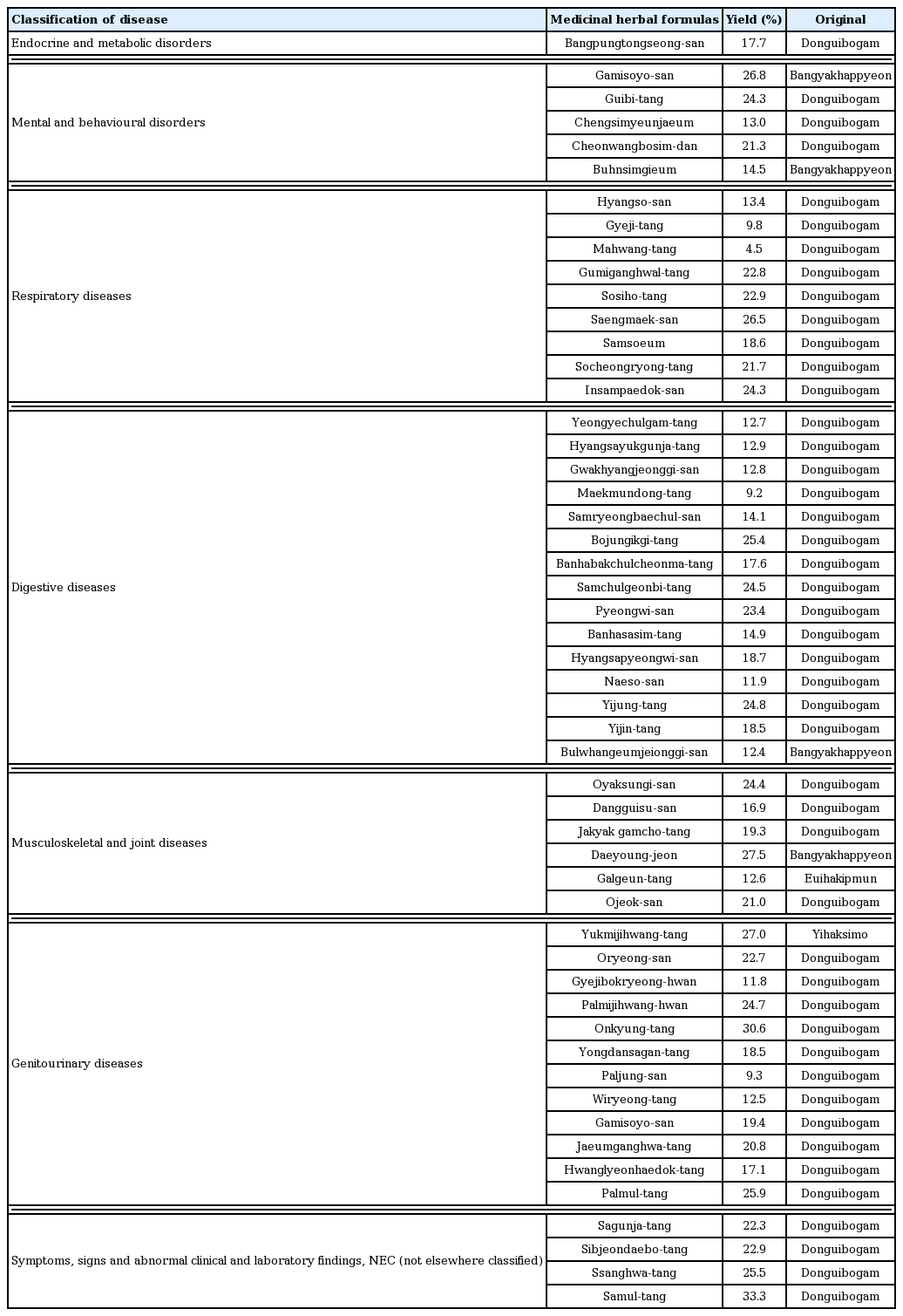Cardiac Safety Assessment of Medicinal Herbal Formulas Using hERG-HEK 293 cell
Article information
Abstract
Objectives
The correlation between medicinal herbal formulas and a risk of cardiotoxicity has been controversial. Thus, this study investigated cardiac safety assessment of 52 most commonly used medicinal herbal formulas.
Methods
We evaluated the in vitro effects of medicinal herbal formulas on recombinant human embryonic kidney 293 (HEK 293) cell line expressing human ether-a-go-go-related gene (hERG) potassium channel.
Results and Conclusion
Our results demonstrated that all of 52 medicinal herbal formulas did not show inhibition of hERG current in hERG-HEK 293 recombinant cells. In conclusion, these safety data suggest that 52 medicinal herbal formulas were not associated with an increased risk of cardiotoxicity in hERG-HEK 293 recombinant cells.
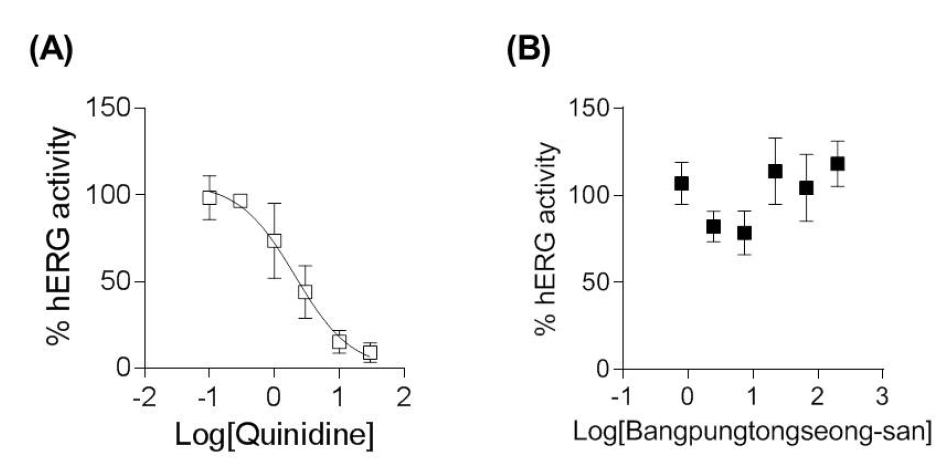
In vitro effects of medicinal herbal formulas used to treat endocrine and metabolic diseases on the hERG current in hERG-HEK 293 recombinant cells. Panel A and B show the dose-response curve of the positive control, Quinidine (panel A, 30 – 0.1 μM) and Bangpungtongseong-san (panel B, 400 – 1.6 μg/ml) in HEK 293 cells. Data are the mean ± SEM (n=3).

In vitro effects of medicinal herbal formulas used to treat mental and behavioural disorders on the hERG potassium channel in hERG-HEK 293 recombinant cells. Panel A – E show the dose-response curve of Gamisoyo-san (panel A, 400 – 1.6 μg/ml), Guibi-tang (panel B, 400 – 1.6 μg/ml), Chengsimyeunjaeum (panel C, 400 – 1.6 μg/ml), Cheonwangbosim-dan (panel D, 400 – 1.6 μg/ml) and Buhnsimgieum (panel E, 400 – 1.6 μg/ml) in hERG-HEK 293 recombinant cells. Data are the mean ± SEM (n=3).
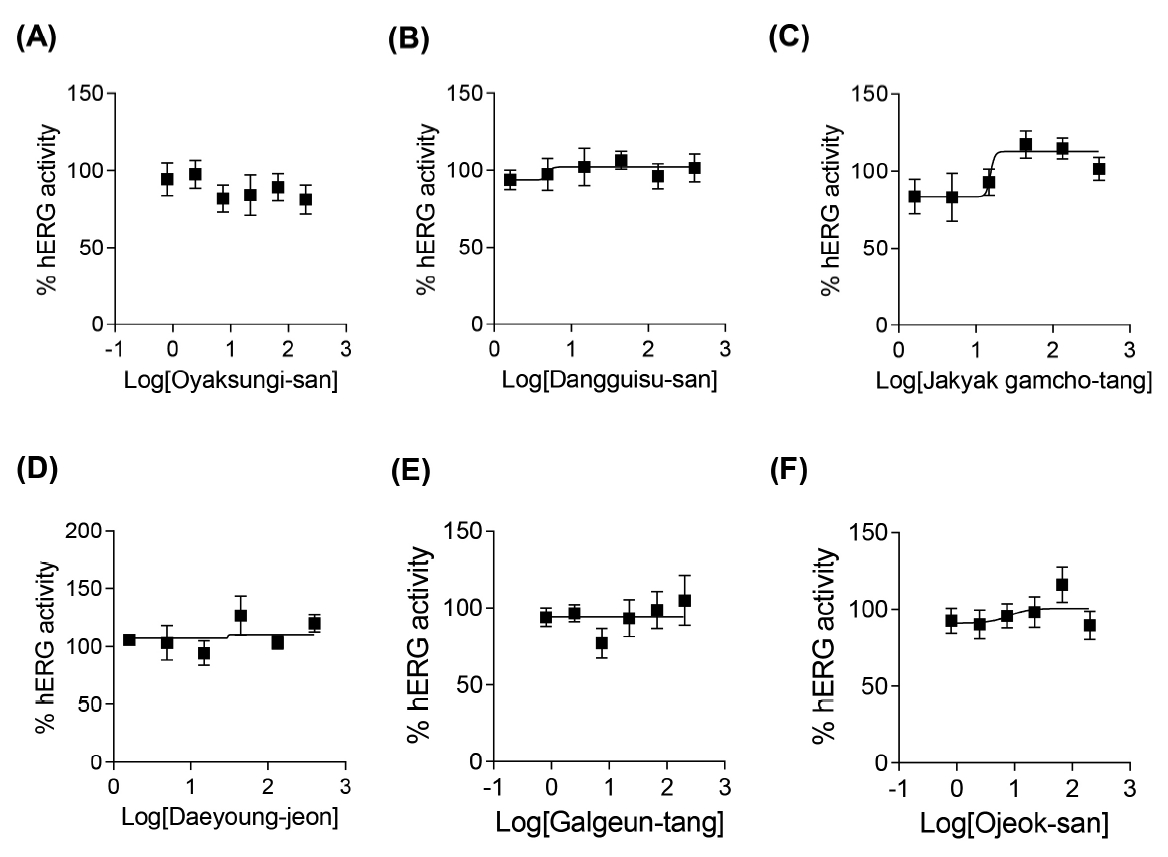
In vitro effects of medicinal herbal formulas used to treat musculoskeletal and joint diseases on the hERG potassium channel in hERG-HEK 293 recombinant cells. Panel A – F show the dose-response curve of Oyaksungi-san (panel A, 400 – 1.6 μg/ml), Dangguisu-san (panel B, 400 – 1.6 μg/ml), Jakyak gamcho-tang (panel C, 400 – 1.6 μg/ml), Daeyoung-jeon (panel D, 400 – 1.6 μg/ml), ), Galgeun-tang (panel E, 400 – 1.6 μg/ml) and Ojeok-san (panel F, 400 – 1.6 μg/ml) in hERG-HEK 293 recombinant cells. Data are the mean ± SEM (n=3).
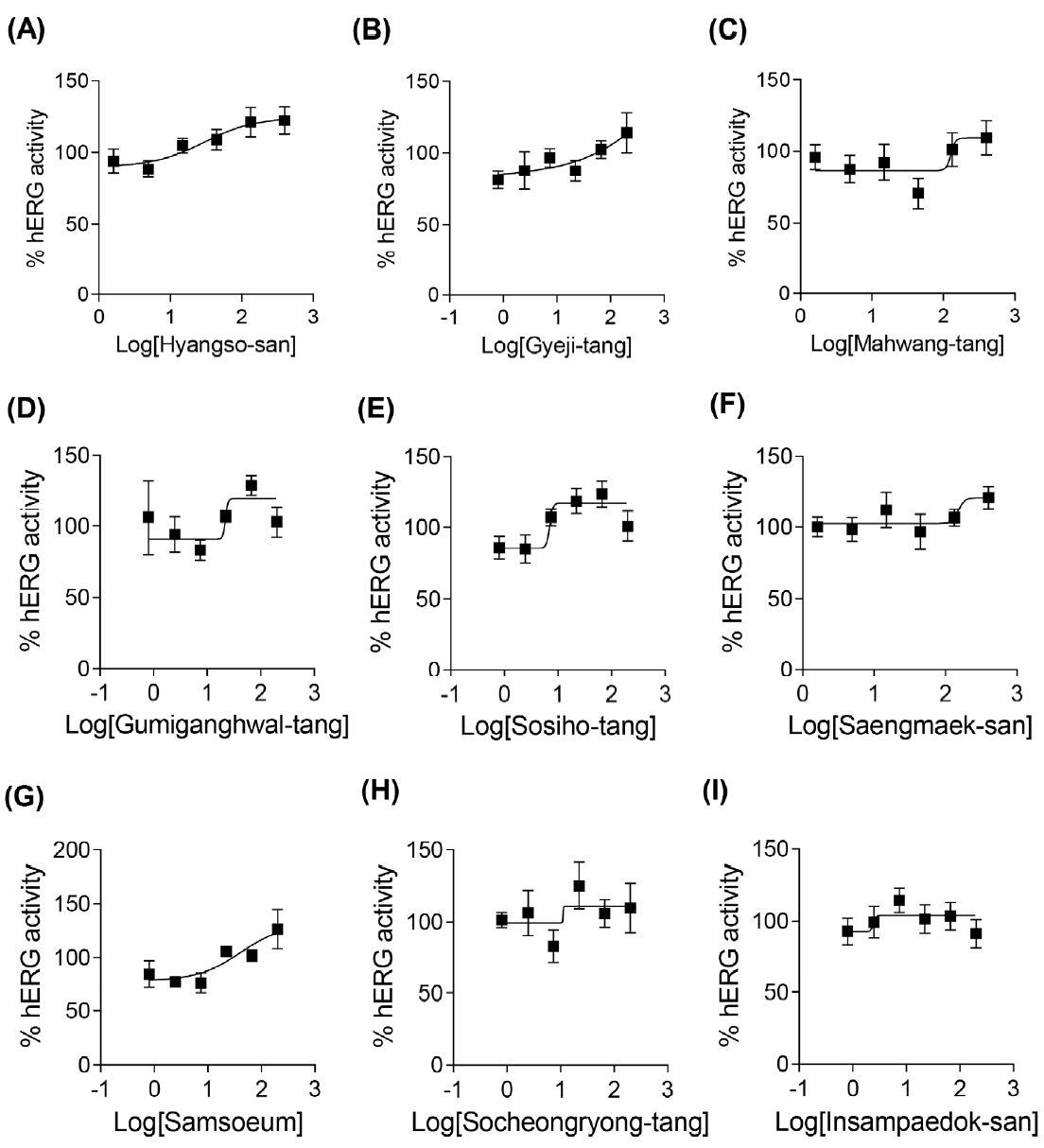
In vitro effects of medicinal herbal formulas used to treat respiratory diseases on the hERG potassium channel in hERG-HEK 293 recombinant cells. Panel A – I show the dose-response curve of Hyangso-san (panel A, 400 – 1.6 μg/ml), Gyeji-tang (panel B, 200 – 0.8 μg/ml), Mahwang-tang (panel C, 400 – 1.6 μg/ml), Gumiganghwal-tang (panel D, 400 – 1.6 μg/ml), Sosiho-tang (panel E, 400 – 1.6 μg/ml), Saengmaek-san (panel F, 400 – 1.6 μg/ml), Samsoeum (panel G, 400 – 1.6 μg/ml), Socheongryong-tang (panel H, 400 – 1.6 μg/ml) and Insampaedok-san (panel I, 400 – 1.6 μg/ml) in hERG-HEK 293 recombinant cells. Data are the mean ± SEM (n=3).
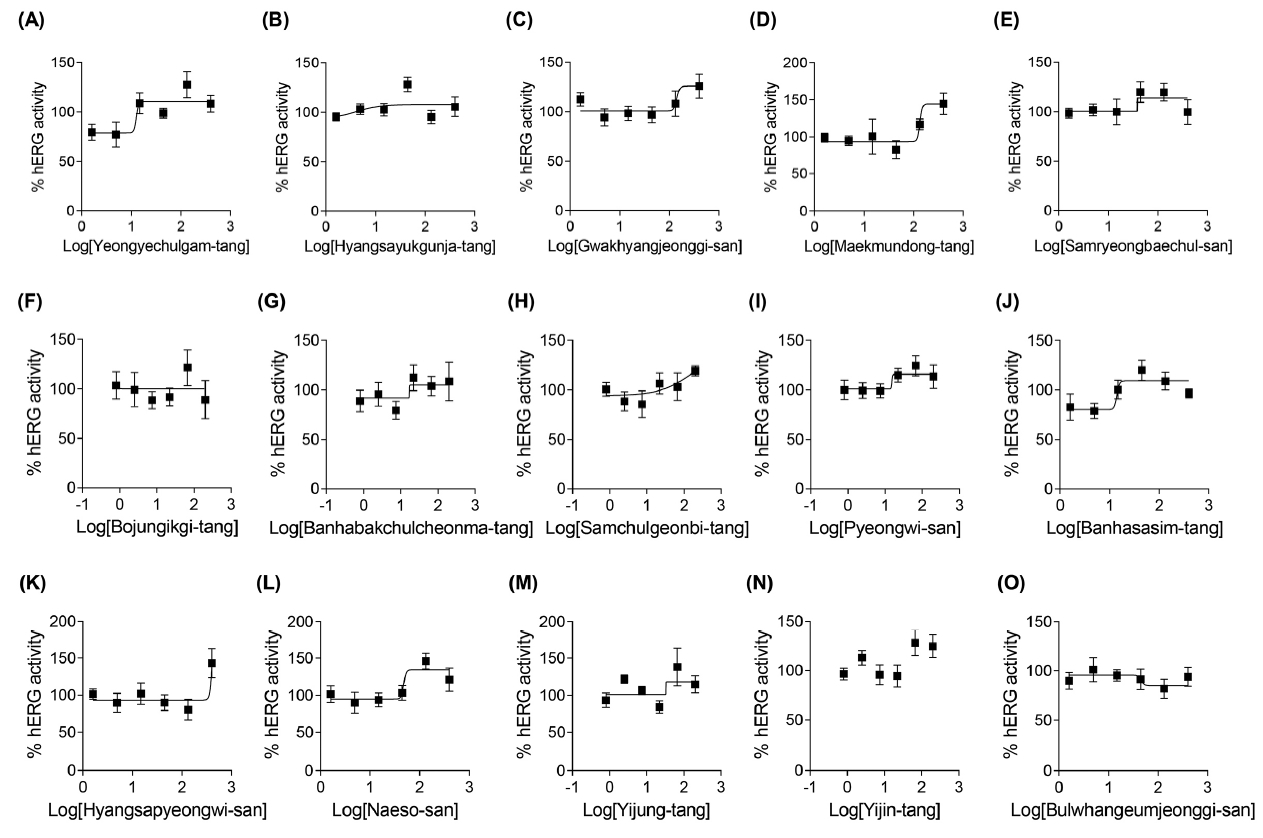
In vitro effects of medicinal herbal formulas used to treat digestive diseases on the hERG potassium channel in hERG-HEK 293 recombinant cells. Panel A – O show the dose-response curve of Yeongyechulgam-tang (panel A, 400 – 1.6 μg/ml), Hyangsayukgunja-tang (panel B, 400 – 1.6 μg/ml), Gwakhyangjeonggi-san (panel C, 400 – 1.6 μg/ml), Maekmundong-tang (panel D, 400 – 1.6 μg/ml) and Samryeongbaechul-san (panel E, 400 – 1.6 μg/ml), Bojungikgi-tang (panel F, 400 – 1.6 μg/ml), Banhabakchulcheonma-tang (panel G, 400 – 1.6 μg/ml), Samchulgeonbi-tang (panel H, 400 – 1.6 μg/ml), Pyeongwi-san (panel I, 400 – 1.6 μg/ml), Banhasasim-tang (panel J, 400 – 1.6 μg/ml), Hyangsapyeongwi-san (panel K, 400 – 1.6 μg/ml), Naeso-san (panel L, 400 – 1.6 μg/ml), Yijung-tang (panel M, 400 – 1.6 μg/ml), Yijin-tang (panel N, 400 – 1.6 μg/ml) and Bulwhangeumjeionggi-san (panel O, 400 – 1.6 μg/ml) in hERG-HEK 293 recombinant cells. Data are the mean ± SEM (n=3).
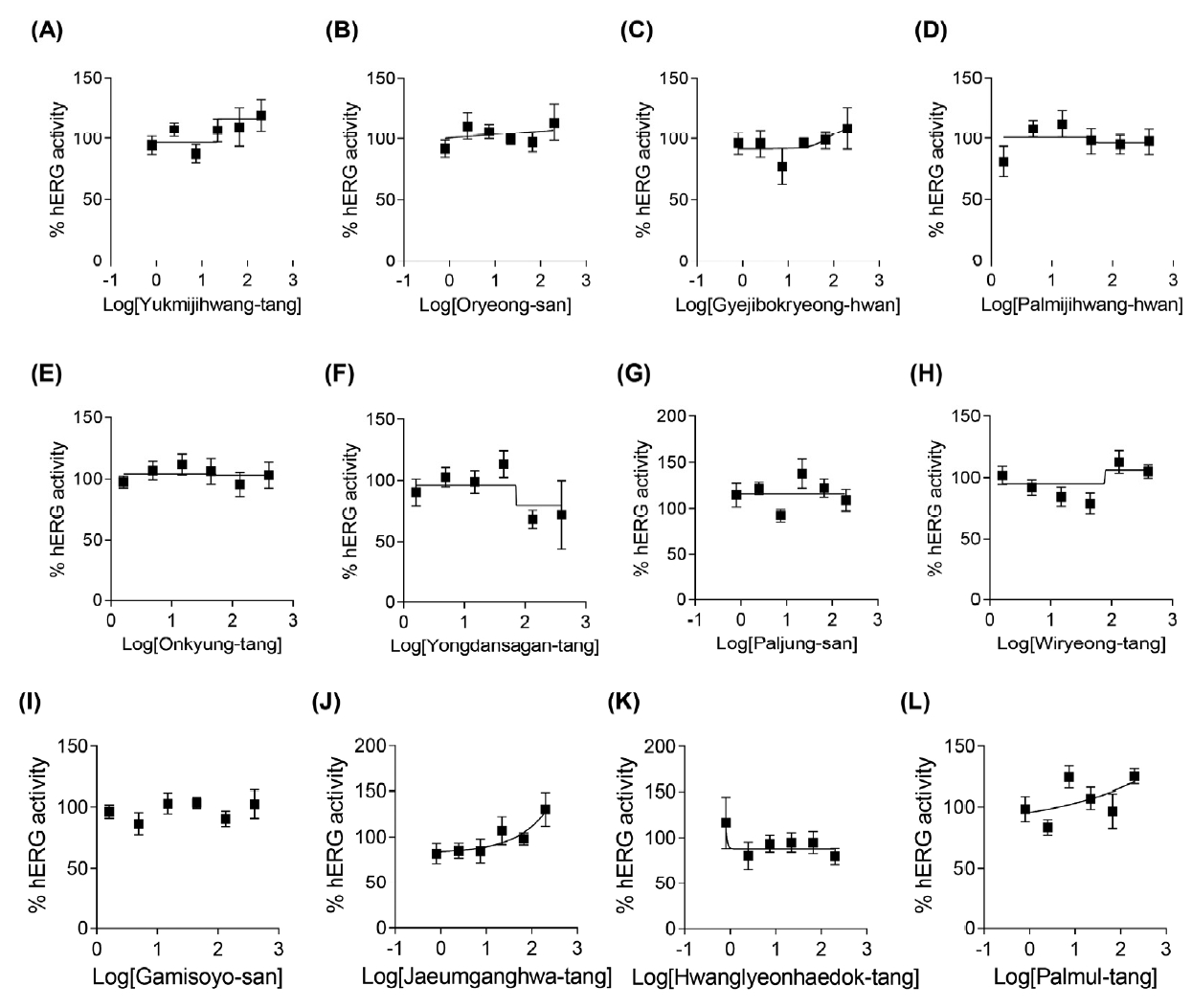
In vitro effects of medicinal herbal formulas used to treat genitourinary diseases on the hERG potassium channel in hERG-HEK 293 recombinant cells. Panel A – L show the dose-response curve of Yukmijihwang-tang (panel A, 400 – 1.6 μg/ml), Oryeong-san (panel B, 400 – 1.6 μg/ml), Gyejibokryeong-hwan (panel C, 200 – 0.8 μg/ml), Palmijihwang-hwan (panel D, 400 – 1.6 μg/ml), Onkyung-tang (panel E, 400 – 1.6 μg/ml), Yongdansagan-tang (panel F, 400 – 1.6 μg/ml), Paljung-san (panel G, 200 – 0.8 μg/ml), Wiryeong-tang (panel H, 400 – 1.6 μg/ml) Gamisoyo-san (panel I, 400 – 1.6 μg/ml), Jaeumganghwa-tang (panel J, 400 – 1.6 μg/ml), Hwanglyeonhaedok-tang (panel K, 400 – 1.6 μg/ml) and Palmul-tang (panel L, 400 – 1.6 μg/ml) in hERG-HEK 293 recombinant cells. Data are the mean ± SEM (n=3).
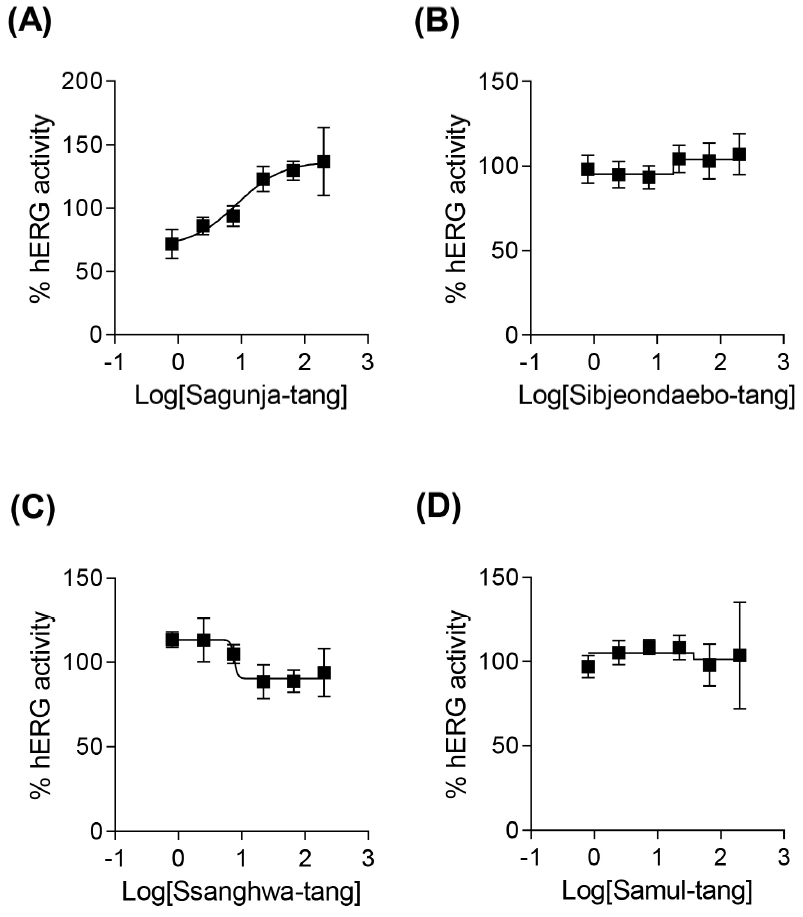
In vitro effects of medicinal herbal formulas used to treat symptoms, signs and abnormal clinical and laboratory findings, NEC (not elsewhere classified) on the hERG potassium channel in hERG-HEK 293 recombinant cells. Panel A – D show the dose-response curve of Sagunja-tang (panel A, 400 – 1.6 μg/ml), Sibjeondaebo-tang (panel B, 400 – 1.6 μg/ml), Ssanghwa-tang (panel C, 400 – 1.6 μg/ml) and Samul-tang (panel D, 400 – 1.6 μg/ml) in hERG-HEK 293 recombinant cells. Data are the mean ± SEM (n=3).

